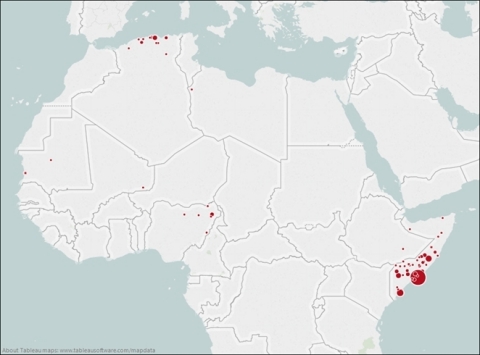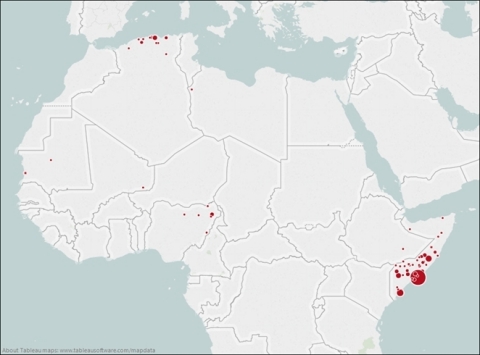LONDON--(BUSINESS WIRE)--The number of militant Islamist attacks in Africa rose dramatically between 2009 and 2015, according to new research released by IHS Inc. (NYSE: IHS), the leading global source of critical information and insight.
In 2009, IHS Jane’s Terrorism and Insurgency Centre recorded 171 militant Islamist attacks across Africa that caused 541 fatalities. In 2015, there were 738 attacks, which resulted in 4,600 fatalities. Attacks have increased over 200 percent and fatalities by more than 750 percent.
“We have seen a dramatic rise in the number of attacks carried out by militant Islamist non-state armed groups across the African continent,” said Matthew Henman, head of IHS Jane’s Terrorism and Insurgency Centre (JTIC). “Boko Haram, Al-Qaeda in the Islamic Maghreb, and Al-Shabaab were the most active groups, but there are new trends emerging that could mean attacks will further intensify.”
New analysis carried out by IHS JTIC indicates three main militant trends evolving in the region:
- Collaboration between Boko Haram and the Islamic State more significant than widely recognized;
- Al-Qaeda in the Islamic Maghreb (AQIM) competing with the Islamic State for territory and recruits; and
- The continuing resilience of Al-Shabaab in the face of growing territorial pressure from a broad array of state adversaries.
Boko Haram – Islamic State’s influence more significant than widely recognized
“The Islamic State has had a more significant impact on Boko Haram than most people think,” Henman said.
Since Boko Haram’s pledge of allegiance to the Islamic State, there has been a qualitative and quantitative increase in the use of suicide bombing tactics in Nigeria and neighboring countries. “The punitive nature of such violence and the calculatedly shocking use of young females as suicide bombers echoed key tactical and operational practices of the Islamic State,” Henman said.
But, notably, Boko Haram has shifted the focus of its media operations since the pledge of allegiance to the Islamic State, with an almost immediate professionalization of propaganda content to match the output of the central group. IHS JTIC research shows Boko Haram tailoring its messages towards a more international audience. The spotlight has shifted away from a focus on Boko Haram emir Abubakar Shekau to focusing primarily on attack videos and refuting government claims. There has also been an emphasis on Arabic over the local Hausa dialect.
“This shift in media operations is no small achievement,” Henman said. “Boko Haram is commonly perceived as a unified, homogenous entity, but it is in fact composed of multiple factions.” Boko Haram’s largest faction, led by emir Shekau, was the one that pledged allegiance to the Islamic State. There are indications that the pledge, and the demand for unity by the Islamic State, has driven a certain degree of rapprochement with one of the key smaller factions, known most commonly as Ansaru.
“The pledge of allegiance from Boko Haram will likely prove critical for the Islamic State in its push to project power and influence as widely as possible,” Henman said. “There are multiple indications that the Islamic State has created links between its affiliates in Libya and West Africa as well as sought to exploit longstanding smuggling routes through the Sahel between North and West Africa.”
AQIM expansion into West Africa to challenge Islamic State
A revitalized AQIM has indicated that it will not remain idle and allow the Islamic State to expand its presence in its primary region of operations. Currently there has been no indication of the competition between the two groups turning violent against each other, with a seeming willingness to escalate violence against a common target set and bid to outdo the other.
“The increased competition between the Islamic State and AQIM raises terrorism risks in West Africa and indicates that attack numbers are unfortunately likely to rise in the six month outlook,” Henman said. “There is also a growing risk of further attacks in countries that have not previously been the target of militant Islamist violence, particularly Senegal and Ghana.”
Since the French intervention into northern Mali in January 2013 AQIM has principally been focused on asymmetric operations against the Malian and French security forces and MINUSMA peacekeeping forces. However, since mid-2015 the group has exploited increased operational space in northern Mali to expand its territorial reach and has gone on the offensive.
AQIM launched several attacks at the end of 2015 and in early 2016, which highlighted its intention to act outside its traditional strongholds in northern Mali. The first of these major attacks occurred in November 2015, when the group attacked the Radisson Blu Hotel in Bamako, Mali. The Bamako assault was followed by an attack on the Cappuccino Café and Splendid Hotel in Ouagadougou, Burkina Faso, in January 2016. Most recently, in March 2016, the group claimed responsibility for an attack that killed 19 people in Grand Bassam, a popular seaside town in Côte d'Ivoire, just outside Abidjan.
“The attacks mark a distinct change for AQIM from the period between 2007 and the first half of 2015, when the group struggled to carry out large-scale attacks, predominantly acted in northern Mali, and rarely attracted significant media attention,” Henman said. “During this period the group had suffered from numerous defections and a strong counter-terrorism drive by Algerian and French forces, which considerably reduced its operational capacity.”
The change of strategy was also likely catalyzed by a renewed alliance between AQIM and al-Murabitoun, including local commander Mokhtar Belmokhtar, who had splintered from AQIM in 2012, but who renewed his alliance with AQIM in late 2015. Belmokhtar has a reputation for "spectacular" attacks and it was unsurprising, the IHS analysis says, that his return to the fold was followed by three of AQIM’s most significant operations for several years.
Al-Shabaab’s resilience and growing threat
Amid a growing international focus on the Islamic State and AQIM operations in North and West Africa, the ongoing and expanding threat posed by Harakat al-Shabaab al-Mujahideen in East Africa has been under-appreciated. “Many people wrote off Al-Shabaab following its expulsion from Mogadishu in 2011 and the subsequent launch of Kenyan, Ethiopian, and AMISOM military incursions into Somalia,” Henman said. “But, over the course of 2015 and 2016, the group has been expanding capabilities and increasing the tempo of attacks.”
Over the course of 2015 and early 2016, Al-Shabaab has underlined its expanding capabilities in Somalia by attacking and overrunning AMISOM peacekeeper bases on three separate occasions, inflicting substantial casualties. The group has successfully isolated key military and peacekeeping positions through southern and central Somalia, enabling it to mass for such assaults and move into territory vacated by AMISOM and local forces. Concurrently Al-Shabaab has maintained a steady tempo of mass casualty attacks against government and security force targets in the capital Mogadishu, underlining the extent of its operational presence therein.
About IHS Jane’s (www.janes.com)
IHS Jane’s, part of IHS Inc. (NYSE: IHS), is the leading open source information provider and conference organiser on defence, international risk and national security to governments, militaries, industries and academia around the globe. IHS is the leading source of insight, analytics and expertise in critical areas that shape today’s business landscape. IHS has been in business since 1959 and became a publicly traded company on the New York Stock Exchange in 2005. Headquartered in Englewood, Colorado, USA, IHS is committed to sustainable, profitable growth and employs nearly 9,000 people in 33 countries around the world.
IHS is a registered trademark of IHS Inc. All other company and product names may be trademarks of their respective owners. © 2016 IHS Inc. All rights reserved.





